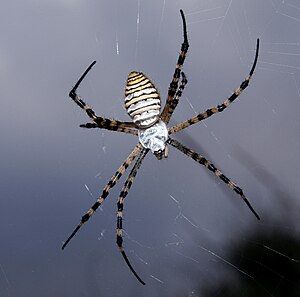Argiope trifasciata
| Argiope trifasciata | ||||||||||||
|---|---|---|---|---|---|---|---|---|---|---|---|---|

Argiope trifasciata , young female |
||||||||||||
| Systematics | ||||||||||||
|
||||||||||||
| Scientific name | ||||||||||||
| Argiope trifasciata | ||||||||||||
| ( Forsskål , 1775) |
Argiope trifasciata (known in English-speaking countries as banded garden spider ) is a spider from the family of the real orb web spiders (Araneidae). It is very similar to the wasp spider ( Argiope bruennichi ), but differs in its transverse banding, in which the individual segments of the drawing are slightly highlighted and clearly delimited.
description
There is a strong gender dimorphism . While males only reach a body length of around 4–5 millimeters, the females with a body length of around 15–25 millimeters are significantly larger. The male is yellow-brown in color, with also yellow-brown legs. The abdomen is brown with white spots. The female's abdomen is gray or yellow in color with black horizontal stripes; the front body has black and some white stripes. The legs are banded dark brown and yellowish. Despite its size, Argiope trifasciata is difficult to see in the net, as the camouflaged belly side hardly stands out against the ground.
distribution and habitat
Argiope trifasciata is distributed worldwide, in North and South America, Africa, Asia, Oceania and Europe. In Europe originally only in Spain and Portugal, in recent years also in Malta, Sardinia and Sicily, and is expanding further.
The species likes to stay on dry grassland, wet meadows, and sandy areas with little vegetation.
Network construction
Argiope trifasciata builds a typical cycle network. The net reaches a diameter of about 60 cm, the nets of the females being larger than those of the males. Depending on the size of the spider, the total length of the web can be around 2 m. The net is built at a height of about 30 cm above the ground.
In a vertical orientation the Argiope trifasciata builds a zigzag-shaped stabiliment . The purpose of this stabilization is disputed. It is possible that it serves as a camouflage for the spider lurking in the middle, but it could also attract insects as prey or warn birds of the otherwise barely visible nets. Spiders that are only active during the day build their webs with Stabiliment. The center of the net is specially reinforced; there you can find the mostly head-down spider, which lurks there for prey.
The spider spends most of its life in its web and usually stays in the same place all summer, but at the beginning of the season they change their location more often, possibly for better protection or better hunting conditions. Female animals are considered to be very faithful to their location, they often stay in the same place their entire life. In autumn the female builds a brown egg cocoon and dies shortly afterwards. The young spiders overwinter in the cocoon and do not leave it until the following spring.
nutrition
Argiope trifasciata mainly feeds on insects. Due to the height of the net, the main food of this species are long-and short-sensor terrors and butterflies, but almost all other insects of suitable size are also captured. As soon as prey is caught in the net, it wraps its victim and kills it with poison. The soft tissues of the prey are liquefied by injected poison and then sucked out ( extraintestinal digestion ). The poison that the spider gives the prey is poisonous, but cannot be dangerous to a healthy person.
Toxicity
The poison of Argiope trifasciata is not dangerous to humans.
Danger
The species is widespread and common in suitable habitats.
Subspecies
The World Spider Catalog currently distinguishes three subspecies for Argiope trifasciata . (As of August 2016)
-
Argiope trifasciata
(Forsskål , 1775)
- Argiope trifasciata deserticola Simon , 1906
- Argiope trifasciata kauaiensis Simon , 1900
- Argiope trifasciata trifasciata (Forsskål , 1775)
Web links
Argiope trifasciata in the World Spider Catalog
- Argiope trifasciata in Fauna Europaea. Retrieved March 15, 2014
Individual evidence
- ↑ a b c Levi HW (1967-1968): The Spider Genera Gea and Argiope in America (Aranea: Araneidae). Harvard University. Bulletin of the Museum of Comparative Zoology 136, 319-353.
- ↑ Nentwig W., T. Blick, D. Gloor, A. Hänggi & C. Kropf (2012): Araneae, Spinnen Europa (identification key) . University of Bern.
- ↑ Natural History Museum of the Burgergemeinde Bern: World Spider Catalog Version 15.5 - Argiope trifasciata . Retrieved September 7, 2014.
- ↑ Di Pompeo P., A. Kulcycki, CM Legittimo & E. Simeon (2011): New records for Europe: Argiope trifasciata (Forsskål, 1775) from Italy and Malta (Araneae, Araneidae). Bulletin of the British Arachn. Society 15 (6), pp. 205-205.
- ↑ Catalog of Life: 26th February 2014. Retrieved March 15, 2014.
- ^ ME Herberstein, CL Craig, JA Coddington and MA Elgar: The functional significance of silk decorations of orb-web spiders: a critical review of the empirical evidence. 200, Biological Reviews 75: pp. 649-669.
- ↑ Natural History Museum of the Burgergemeinde Bern: World Spider Catalog Version 17.5 - Argiope trifasciata . Retrieved August 2, 2016.